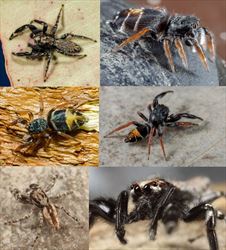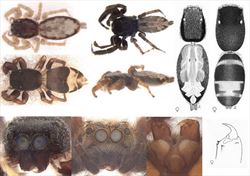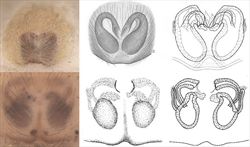
Examples of live Apricia
Illustrators (and ©) R. Whyte (Tl, ML), I.R. Macaulay

Aspects of the general morphology of Apricia
Illustrators (and ©) B.J. Richardson (CSIRO & MP), M. Zabka (diag.) (QMB)

Palp morphology of Apricia
Illustrators (and ©) B.J. Richardson (CSIRO & MP), M. Zabka (diag,) (QMB)

Epigyne morphology of Apricia
Illustrators (and ©) B. Richardson (CSIRO & MP) & M. Zabka (TM, TL) (QMB)
Apricia Richardson, 2016
Taxonomy
Apricia has three Australian species: Apricia jovialis, A. bracteata and A. longipalpis. The genus is part of a clade of Australasian genera (Maddison et al 2008) including Abracadabrella, Clynotis, Holoplatys, Huntiglennia, Ocrisiona, Opisthoncus, Paraphilaeus, Paraplatoides, Pungalina, Tara, Trite and Zebraplatys (Maddison 2015). Further information on the genus and described species can be found in Richardson and Żabka (2017) and Whyte and Anderson (2017).
Description
Apricia spp. are medium to large-sized spiders, ranging in body length from 8 to 10 mm. They have a low but not greatly compressed profile when viewed from the side. When viewed from above, the head is roughly elliptical and the abdomen elongate-ovate. Chelicerae in both males and females have a single retromarginal tooth (unident) and two teeth on the promargin. The first pair of legs is much stronger than the others. The tibias of the first and third pairs of legs on some species have tiny spines while the tibia of the fourth pair of legs is without spines.
The male’s palp has a long cymbium and a rounded tegulum with a large proximal lobe. The size of the embolus varies with the species but always rises from a distinct mound on the distal edge of the tegulum. The retro-lateral tibial apophysis varies from short and pointed to short and blunt.
The female’s epigyne is without clear guides or well-developed epigynal atria. The pear-shaped spermathecae are large, their lower edges close to the epigastric fold. The copulatory openings are between (medial to) or anterior to the spermathecae.
Biology
Apricia is found on or under bark or on foliage and other surfaces in a wide range of habitats from rainforest to semi-desert. It is often found in houses and on sunny walls. Apricia jovialis is reported to cause painful bites with local swelling, discoloration and sometimes headaches.
Distribution
Apricia is found throughout Australia in all States and Territories including Tasmania.
References
Davies, V.T. & Żabka, M. 1989. Illustrated keys to the genera of jumping spiders (Araneae: Salticidae) in Australia. Memoirs of the Queensland Museum 27, 189-266.
Maddison, W.P. 2015. A phylogenetic classification of jumping spiders (Araneae: Salticidae). Journal of Arachnology 43, 231-292.
Maddison, W.P., Bodner, M.R. & Needham, K.M. 2008. Salticid spider phylogeny revisited, with the discovery of a large Australian clade (Araneae: Salticidae). Zootaxa 1893, 49-64.
Richardson, B.J. 2016. New genera, new species and redescriptions of Australian jumping spiders (Araneae: Salticidae). Zootaxa 4114, 501-560.
Richardson, B.J. & Żabka , M. 2017. Salticidae. Arachnida: Araneomorphae. Canberra, Australian Faunal Directory. Australian Biological Resources Study, at https://biodiversity.org.au/afd/taxa/SALTICIDAE.
Whyte, R. & Anderson, G. 2017. A Field Guide to Spiders of Australia. CSIRO Publishing: Clayton.
* The information sheet should be interpreted in the context of the associated diagrams and photographs. Diagrams explaining anatomical terms can be found in the ‘Salticidae’ pictures at the beginning of the list of genera.